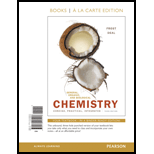
To determine:
The dilution factor of the solution if
Introduction:
Dilution of a solution means decreasing the concentration of the solution. By adding extra volume of the solution, the concentration of the solute decreases in the solution.
Dilution factor is the ratio of final volume of the solution to the initial volume of solution.
The dilution factor is given by the expression,
To determine:
The concentration of final solution if
Introduction:
The relation between the volume of solution and concentration is given by the expression,
The concentration of final solution is given by the expression,
Want to see the full answer?
Check out a sample textbook solution
Chapter 8 Solutions
GENERAL ORGANIC+BIO...(LL)-W/MOD.ACCESS
- a. Starting with a 1M stock of NaCl, a researcher prepares a 100 mM working solution. The dilution factor is: b. To prepare 50 ml of a 100 mM solution of NaCl, starting from a 1M stock of NaCl, a researcher should add ____ (volume with units) of the 1M stock to ____ (volume with units) of dilutent.arrow_forwardA liniment contains 15 % (v/v) of methyl salicylate. How many mL of the liniment can be made from 1 pint of methyl salicylate? Volume(ml) x %(expressed in decimal)= mL of active ingredientsarrow_forwardA solution is made using 200.0 mL of methanol (density 0.792 g/mL) and 1011.1 mL of water (density 1.000 g/mL). What is the mass percent of the methanol?arrow_forward
- A physician orders Keflin 500 mg evry six hours for your patient. Keflin 1 gm/10ml is available for use. How many mL will you despense to the patient every six hours?arrow_forwardA 150 mL solution of 2.3x10-3 M HCl was prepared from a stock solution of 10 M HCl. a. What is the volume from the stock solution to make the 2.3 x10-3 M HCl? Use correct number of significant figures.arrow_forward6.7 mL of saturated chloride solution was added to a 54.730 g evaporated dish. The combination weighed 61.945 g. After evaporation the dish and contents weighed 55.428 g. What was the mass percent of potassium chloride in the solution?arrow_forward
- Diuril is a prescription drug used to treat hypertension. You are given a 2.5 g vial of Diuril, with negligible volume, and asked to prepare a solution by combining with 20.0 mL of sterile water. What is the final concentration in mg/mL?arrow_forwardA saline irrigation is being prepared such as 9 mg NaCl is present in each ml. How many grams of NaCl are needed to prepare 2 quarts of the irrigation? (ROUND TO A WHOLE NUMBER)arrow_forwardWhat is the volume of a solution which contains 50 mg of a drug at a 12% strength?arrow_forward
- an antibiotic suspension was prepared by adding 85 mL of distilled water to 28 gr of antibiotic powder mix. If the volume of the final product was 120 mL, the specific gravity of the antibiotic suspension is ______.arrow_forwardA 6.00 % (m/v) NaCl solution contains 49.2 g of NaCl. What is the total volume (V) of the solution in milliliters?arrow_forwardComplete the following problems. Show the correct number of significant figures and units in your results. 1. When an aqueous salt solution with a mass of 75 g is evaporated to dryness, 4.5 g of salt remains. What percentage of the original salt solution was water? Show your work with units to receive credit.arrow_forward
 Chemistry: Principles and ReactionsChemistryISBN:9781305079373Author:William L. Masterton, Cecile N. HurleyPublisher:Cengage LearningChemistry: Matter and ChangeChemistryISBN:9780078746376Author:Dinah Zike, Laurel Dingrando, Nicholas Hainen, Cheryl WistromPublisher:Glencoe/McGraw-Hill School Pub Co
Chemistry: Principles and ReactionsChemistryISBN:9781305079373Author:William L. Masterton, Cecile N. HurleyPublisher:Cengage LearningChemistry: Matter and ChangeChemistryISBN:9780078746376Author:Dinah Zike, Laurel Dingrando, Nicholas Hainen, Cheryl WistromPublisher:Glencoe/McGraw-Hill School Pub Co

